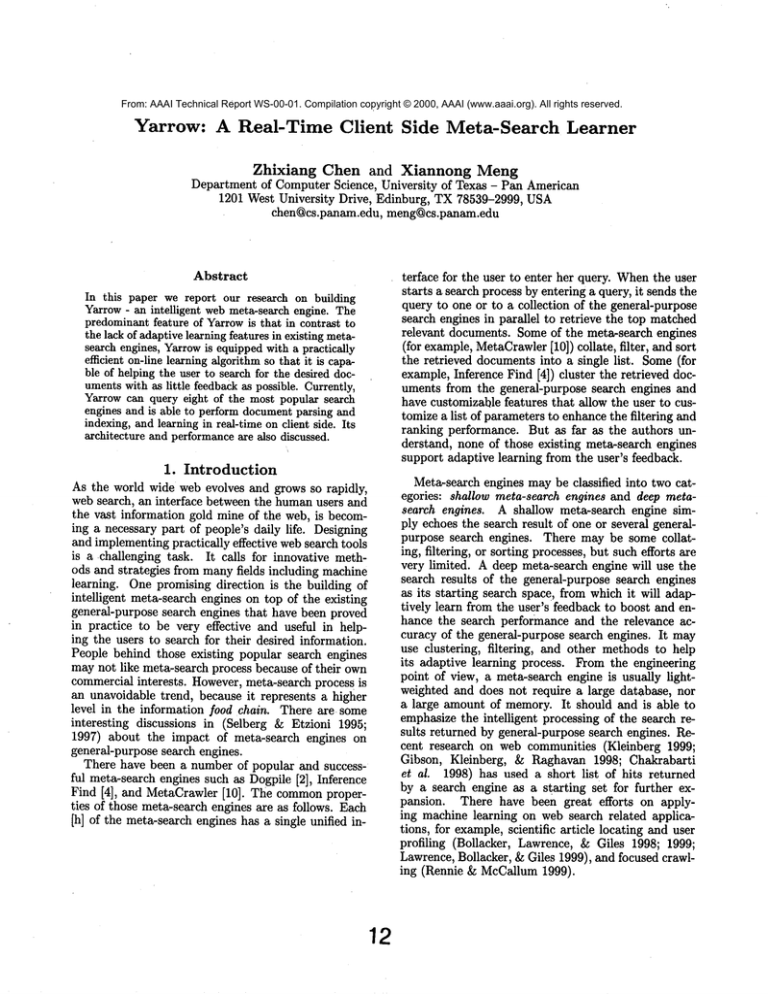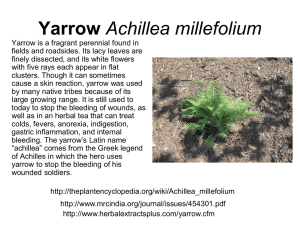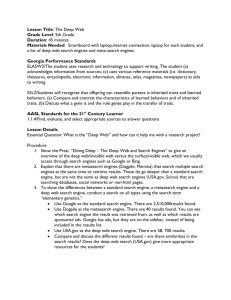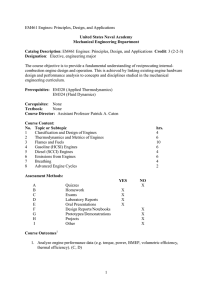
From: AAAI Technical Report WS-00-01. Compilation copyright © 2000, AAAI (www.aaai.org). All rights reserved.
Yarrow: A Real-Time
Client
Side Meta-Search
Learner
Zhixiang
Chen and Xiannong
Meng
Department of Computer Science, University of Texas - Pan American
1201 West University Drive, Edinburg, TX 78539-2999, USA
chen~cs.panam.edu, meng@cs.panarn.edu
Abstract
In this paper we report our research on building
Yarrow- an intelligent web meta-search engine. The
predominantfeature of Yarrowis that in contrast to
the lack of adaptive learning features in existing metasearch engines, Yarrowis equippedwith a practically
efficient on-line learning algorithmso that it is capable of helping the user to search for the desired documentswith as little feedbackas possible. Currently,
Yarrow can query eight of the most popular search
engines and is able to perform documentparsing and
indexing, and learning in real-time on client side. Its
architecture and performanceare also discussed.
1. Introduction
As the world wide web evolves and grows so rapidly,
web search, an interface between the humanusers and
the vast information gold mine of the web, is becoming a necessary part of people’s daily life. Designing
and implementing practically effective web search tools
is a challenging task. It calls for innovative methods and strategies from manyfields including machine
learning. One promising direction is the building of
intelligent meta-search engines on top of the existing
general-purpose search engines that have been proved
in practice to be very effective and useful in helping the users to search for their desired information.
People behind those existing popular search engines
may not like meta-search process because of their own
commercial interests. However, meta-search proces s is
an unavoidable trend, because it represents a higher
level in the information food chain. There are some
interesting discussions in (Selberg & Etzioni 1995;
1997) about the impact of meta-search engines on
general-purpose search engines.
There have been a number of popular and successful meta-search engines such as Dogpile [2], Inference
Find [4], and MetaCrawler [10]. The commonproperties of those meta-search engines are as follows. Each
[h] of the meta-search engines has a single unified in-
terface for the user to enter her query. Whenthe user
starts a search process by entering a query, it sends the
query to one or to a collection of the general-purpose
search engines in parallel to retrieve the top matched
relevant documents. Some of the meta~search engines
(for example, MetaCrawler[10]) collate, filter, and sort
the retrieved documents into a single list. Some(for
example, Inference Find [4]) cluster the retrieved documents from the general-purpose search engines and
have customizable features that allow the user to customize a list of parameters to enhance the filtering and
ranking performance. But as far as the authors understand, none of those existing meta-search engines
support adaptive learning from the user’s feedback.
Meta-search engines may be classified into two categories: shallow meta-seareh engines and deep metasearch engines. A shallow meta-search engine simply echoes the search result of one or several generalpurpose search engines. There may be some collating, filtering, or sorting processes, but such efforts are
very limited. A deep meta~search engine will use the
search results of the general-purpose search engines
as its starting search space, from which it will adaptively learn from the user’s feedback to boost and enhance the search performance and the relevance accuracy of the general-purpose search engines. It may
use clustering, filtering,
and other methods to help
its adaptive learning process. From the engineering
point of view, a meta~search engine is usually lightweighted and does not require a large database, nor
a large amount of memory. It should and is able to
emphasize the intelligent processing of the search results returned by general-purpose search engines. Recent research on web communities (Kleinberg 1999;
Gibson, Kleinberg, & Raghavan 1998; Chakrabarti
et al. 1998) has used a short list of hits returned
by a search engine as a starting set for further expansion. There have been great efforts on applying machine learning on web search related applications, for example, scientific article locating and user
profiling (BoUacker, Lawrence, & Giles 1998; 1999;
Lawrence, Bollacker, & Giles 1999), and focused crawling (Rennie & McCallum1999).
Yarrow is our first step toward building an intelligent deep meta-search engine. Currently, Yarrow
can query eight of the most popular general-purpose
search engines and is able to perform document parsing and indexing, and learning in real-time on client
side. The predominant feature of Yarrow is that in
contrast to the lack of adaptive learning features in
existing meta-search engines, Yarrow is equipped with
an on-line learning algorithm TW2so that it is capable of helping the user to search for the desired documents with as little feedback as possible. We designed in (Chen 2000b) the learning algorithm TW2,
a tailored version of Winnow2(Littlestone 1988)
the case of web search. Whenused to learn a disjunction of at most k relevant attributes,
TW2has
surprisingly small mistake bounds that are independent of the dimensionality of the indexing attributes.
TW2has been successfully used as part of the learning
components in our other projects (Chen et al. 2000b;
2000a).
2. Web Search vs. On-line Learning
As we have investigated in (Chen 2000b; Chen, Meng,
& Fowler 1999; Chen et al. 2000b), intelligent
web
search can be modeled as an adaptive learning process such as on-line learning (Angluin 1987; Littlestone
1988), where the search engine acts as a learner and the
user as a teacher. The user sends a query to the engine, and the engine uses the query to search the index
database and returns a list of urls that are ranked according to a ranking function. Then the user provides
the engine relevance feedback, and the engine uses the
feedback to improve its next search and returns a refined list of urls. The learning (or search) process ends
when the engine finds the desired documents for the
user. Conceptually a query entered by the user can
be understood as the logical expression of the collection of the documents wanted by the user. A list of
urls returned by the engine can be interpreted as an
approximation to the collection of the desired documents.
One must realize that in the case of web search the
user in general has no patience to try more than a couple of dozens of interactions for a search process, nor
to wait for a dozen of minutes for the engine to return
the search results. One must also realize that the dimensionality of the web document indexing attributes
is extremely high (usually, a huge vocabulary of keywords is used as indexing attributes). In such reality
of web search, few well-established machine learning
algorithms are applicable to web search.
The Rocchio’s similarity-based relevance feedback,
the most popular query formation method in information retrieval (J.J. Rocchio 1971; Salton 1989;
Baeza-Yates & Riberiro-Neto 1999), is in essence an
adaptive learning process from examples. Weproved
in (Chen & Zhu 2000) that for any of the four typical similarity measurements (inner product, cosine
13
coefficient, dice coefficient, and Jaccard coefficient)
(Salton 1989), the learning algorithm from relevance
feedback has a linear lower bound in the dimensionality of Boolean vector space. In the discretized vector
space {0,..., M- 1}n, the lower bound of the relevance feeback algorithm for any of the above four similarity
measurements is f~(Mn) (Chen 2000a). Our
lower bounds hold for arbitrary zero-one initial query
vectors, and for arbitrary threshold and updating coefficients used at each step of the learning process. Our
lower bounds imply that in contrast to various successful applications, at least in theory the Rocchio’s
similarity-based relevance feedback algorithm is not a
good choice for web search.
We use the vector space model (Salton, Wong,
Yang 1975; Salton 1989; Baeza-Yates & Riberiro-Neto
1999) to represent documents. Weintroduce TW2,
tailored version of Winnow2,to exploit the particular
nature of web search. In contrast to the fact that Winnow2sets all initial weights to 1, TW2sets all initial
weights to 0 and has a different promotion process accordingly. The rationale behind setting all the initial
weights to 0 is not as simple as it looks. The motivation is to focus attention on the propagation of the
influence of the relevant documents, and use irrelevant
documents to adjust the focused search space. Moreover, this approachis realistic because existing effective
document ranking mechanisms can be coupled with the
learning process as discussed in next section.
Algorithm TW2 (The tailored
Winnow2). TW2
maintains non-negative real-valued weights wl , . . . , wn
for attributes attl,...,
attn, respectively. It also maintains a real threshold O. Initially, all weights have
value O. Let a > 1 be the promotion and demotion factor. TW2classifies documents whose vectors
x = (xl, "’" Xn)
satisfy Ei=I Wi’Ti > 0 as relevant,
’
and all others as irrelevant. If the user provides a document that contradicts to the classification of TW2,
then we say that TW2makes a mistake. Let Wi,b and
w~,a denote the weight wi before the current update and
after, respectively. Whenthe user responds with a document which contradicts to the current classification,
TW2updates the weights in the following two ways:
¯ Promotion: For a document judged by the user
as relevant with vector x = (xx,...,xn),
for i
1,..., n, set
Wi, a ~--
I
Wi,b, if Xi = O,
~,
if Xi = 1 and Wi,b = O,
OtWi,b, if Xi = 1 and Wi,b ~ O.
¯ Demotion: For a document judged by the user as
irrelevant with vector x = (Xl,...,xn),
for
i =
1, . . . , n, set
wi,a
Wilb
=a "
Let A denote the total number of distinct indexing
attributes of all the relevant documentsthat are judged
by the user during the learning process. Four mistake
bounds are obtained for TW2and their formal proofs
User
Interface
:[(
1
i °i,pl,,or
1
f
1
UAVMetaSe~c"e_.~
... I Yl-IMetaSearche~J
Ranker
¢
Figure 1: Architecture of WebSail
can be found in (Chen 2000b; Chen et al. 2000b). For
example, to learn a collection of documentsrepresented
by a disjunction of at most k relevant attributes over
the n-dimensional boolean space, TW2makes at most
cz2A
+ (a + 1)klna 0 - a mistakes.
3.
The
Yarrow
3.1.
The Architecture
of Yarrow and How
It Works
Yarrow is a multi-threaded program coded in C++. Its
architecture is shownin Figure 1. It runs on an Ultra 1
Sun Workstation and does not require a large database
or a large amount of memory. For each search process it creates a thread and destroys the thread when
the search process ends. Because of its light-weighted
size it can be easily converted or ported to run in
different environments or platforms. The QueryConstructor, MetaSearchers, DocumentParser, and DocumentIndexer are designed in such a way that they can
be scaled to meta-search other popular general-purpose
search engines, and can be expanded with new features
added to it.
The predominant feature of Yarrow, compared with
existing meta-search engines, is the fact that it learns
from the user’s feedback in real-time on the client side.
The learning algorithm TW2used in Yarrow has a
proved surprisingly small mistake bound (Chen 2000b;
Chen et al. 2000b). Yarrow may be well used as
plug-in componentfor web browsers on the client side.
Yarrow has an interface as shown in Figure 2. Using this interface, the user can enter her query, specify
the number of urls she wants to be returned, and select one of the eight popular general-purpose search
engines to perform the initial search. Having entered
her query information, she then clicks the search button to start Yarrow. Once started, Yarrow invokes its
Query/Feedback Parser to parse the query information
or the feedback information out from the interface.
Then, the Dispatcher of Yarrow decides whether the
current task is an initial search process or a learning
process. If it is an initial search process, then the Dispatcher calls the QueryConstructor to formulate the
query to fit the specific format of the target search engine, and send the formulated query and the number
of urls wanted to the related MetaSearcher to get a
list of the most relevant documents from the generalpurpose search engine. After this, Yarrowcalls its DocumentParser and DocumentIndexer to parse the received documents, to collate them and to index them
with at most 64 indexing attributes.
The set of the
indexing attributes are automatically extracted from
the retrieved documents. The attribute-vector
representations for all the received documentsare also constructed at this point. Yarrowfinally presents the top
R and the bottom R of the collated list of the retrieved
documents to the user for her to judge the relevance
of the documents. Usually, Yarrow sets R to 10. The
format of presenting the top R and the bottom R documents is shown in Figure 3. In this case, each document url is proceeded by two radio buttons for the
user to indicate whether the document is relevant or
not1. The urls are clickable for viewing the actual documents so that the user can make her judgment more
accurately. After the user clicks a few radio buttons
for selection of relevant and irrelevant documents, she
can click the FeedBack button to submit the feedback
to Yarrow, or click the ShowAllbutton to view all the
document urls, or enter a new query to start a new
search process.
If the current task is a learning process from the
user’s relevance feedback, The Dispatcher sends the
relevance feedback information to the learning algo1The search process shownin Figures 3 and 4 was performed on March 1, 2000. The query word is "UTPA"
and the desired web documentsare those related to "the
University of Texas- Pan American".The selected generalpurpose search engine is Northern Light. After 2 interactions and 5 relevant and irrelevant documentsjudged by
the user as feedback, all the UTPA
related web documents
amongthe initial 50 matcheddocumentswere movedto the
top 10 positions.
Figure 2: Interface of Yarrow
rithm TW2. "TW2uses the relevant and irrelevant
documents judged by the user as positive and negative examples to promote and demote the weight vector, respectively. TW2also does individual document
promotion or demotion for those judged documents.
Once TW2finishes its updating process, Yarrow then
calls its Ranker to re-rank all the documentsand later
presents the top R and the bottom R to the user for
the next step of learning.
3.2.
Document Ranking and Equivalence
Query Simulation
Since in reality the user cannot be modeledas a teacher
as on-line learning does (Angluin 1987; Littlestone
1988), the learning algorithm TW2must be used with
help of document ranking and equivalence query simulation.
Let w = (wl,... ,Wn) be the weight vector of TW2.
Let g be a ranking function independent of TW2.We
define the ranking function f for TW2as follows: For
any web document d with vector Xd = (Xl,... ,xn),
f(d) = "/d[g(d) +/~d] + ~ WiXi.
i=l
g remains constant for each document d during the
learning process of TW2. Various strategies can be
used to define g, for example, PageRank (Brin & Page
1998). The two additional tuning parameters are used
to do individual document promotions or demotions
of the documents that have been judged by the user
as feedback during the learning process of TW2.The
motivation for individual document promotions or demotions is that when the status of a documentis clear
as judged by the user, it should be placed closer to the
top than the rank supported by the weighted sum of
TW2if it is relevant, or placed closer to the bottom
otherwise. Initially, let/~d --> 0 and ’Td = 1. ’~d and/~d
can be updated in the similar fashion as wi is updated
by TW2.
Yarrow uses the ranking function ] to rank the documents classified by TW2and returns the top R rel-
15
evant documents and the bottom R irrelevant to the
user. The top R and the bottom R documents together
represent an approximation to the hypothesis made by
TW2. The user can examine these two short lists. If
she feels satisfactory with the result then she can say
"yes" to end the search process. If she finds that some
documentsin the lists are misclassified, then she can
indicate those to TW2as relevance feedback. Because
normally the user is only interested in the top 10 to 50
ranked documents, R can be tuned between 10 and 50.
An alternative way for selecting, the bottom R documents is to randomly select R documents amongthose
classified as irrelevant by the learning algorithm.
3.3.
The Performance
The actual performance of Yarrow is very impressive
and promising. Wehave made Yarrow public. Interested readers can access it via the url given at the end
of the paper and can check its performance by themselves. Currently, we have been conducting formal performance evaluations and will report the statistics in
the full version of this paper soon. What we can say at
this point is that for each search process, very satisfactory result can be achieved with about 5 interactions
and about 17 documents judged as relevance feedback.
For documentindexing, in average a collection of about
700 attributes are automatically extracted and each retrieved documentis indexed with at most 64 attributes
from the collection.
4.
Yarrow
and the Popular
Meta-search
Engines
Wenow compare Yarrow with the following three of
the most popular and successful meta-search engines,
2.
Dogpile [2], Inference Find [4], and MetaCrawler[10]
Dogpile [2]. It queries the following generalpurpose search engines or services: About.corn, AltaVista, Deja News, Direct Hit, Dogpile Open Direc2Wecollected the features of the three meta-searchengines on February29, 2000.
~"
~ ..........................
Figure 3: Initial
~11~]
Query Result for "UTPA"
tory, Dogpile Web Catalog, Google, GoTo.com, Infoseek, Infoseek NewsWires, Looksmart, Lycos, Real
Names, Thurderstone, Yahoo!, and Yahoo News Headlines. It performs parallel queries to those search services, but also allows the user to customize her search
to one specific engine. It does not sort, collate, nor
cluster the lists of hits returned by each search service.
It has no adaptive learning features from the user’s
feedback.
Inference Find [4]. It queries the following generalpurpose search services: AltaVista, Excite, Infoseek,
Lycos, WebCrawler, and Yahoo!. It performs parallel
queries to those search services, but does not allow the
user to customize her search. It sorts and clusters the
lists of hits returned by the search services. It has no
adaptive learning features from the user’s feedback.
MetaCrawler[10]. It queries the following generalpurpose search services: About.corn, AltaVista, Excite, Infoseek, Looksmart, Lycos, Thunderstone, WebCrawler, and Yahoo! It performs parallel queries to
those search services, and also allow the user to customize her search to one specific engine. It collates
and sorts the lists of hits returned by the search services. It normalizes the confidence scores used by each
of the service, sums the scores and rank them from 1
to 1000. It has no adaptive learning features from the
user’s feedback.
Yarrow [14]. It queries the following generalpurpose search services: AltaVista, Excite, GoTo,HotBot, Infoseek, Lycos, Northern Light, and Yahoo!. It
does not support parallel queries at this point, but allows the user to specify her favorite search service. Its
most important feature is its real-time adaptive learning ability from the user’s feedback.
5. Concluding
Remarks
The authors believe that deep meta-search should be
the ultimate goal of meta-search, that is, a meta-search
engine or service should use the retrieved lists of hits
from one or a collection of general-purpose search engines or services as its starting search space, from
16
which it should adaptively learns from the user’s feedback to boost and enhance the search performance and
accuracy of the general-purpose search services. From
the engineering point of view, deep meta-search is possible, because a meta-search engine is usually lightweighted and does not require a large database nor a
large amount of memory. As the first step to achieve
our goal of deep meta-search, we implemented Yarrow
during the winter break of the 1999-2000 academic
year. Yarrowis powered by an efficient learning algorithm and is also equipped with functions of document
parsing and indexing. It adaptively learns from the
user’s feedback to search for the desired documents.
Yarrowis still in its initial stage and needs to be improved and enhanced in many aspects. For example,
we need to improve its thread management. The current version is easy to crash when too many threads
competing for the limited memoryresources.
URL References:
[1] AltaVista: www.altavista.com.
[2] Dogpile: www.dogpile.com.
[3] Excite: www.excite.com.
[4] Inference Find: www.infind.com.
[5] Infoseek: www.infoseek.com.
[6] Google: www.google.com.
[7] GoTo: www.goto.com.
[8] HotBot: www.hotbot.com.
[9] Lycos: www.lycos.com.
[10] MetaCrawler: www.metacrawler.com.
[11] Northern Light: www.northernlight.com.
[12] WebSail:
www.cs.panam.edu/chen/WebSearch/WebSall.html.
[13] Yahoo!: www.yahoo.com.
[14] Yarrow:
www.cs.panam.edu/chen/WebSearch/Yarrow.html.
[15] Features:
www.cs.panam.edu/chen/WebSearch/Features.html.
cysseno77~.342
~u~’~ww.u~m,~ng~.e~cs.shu~
Figure 4: Refined Result for "UTPA"after 2 Interactions
References
Angluin, D. 1987. Queries and concept learning.
chine Learning 2:319-432.
Ma-
Baeza-Yates, R., and Riberiro-Neto, B. 1999. Modern
Information Retrieval. Addison-Wesley.
Bollacker, K.; Lawrence, S.; and Giles, C. L. 1998.
Citeseer: An autonomous web agent for automatic
retrieval and identification of interesting publications.
In Proceedings of the Second International Conference
on Autonomous Agents, 116-113. New York: ACM
Press.
Bollacker, K.; Lawrence, S.; and Giles, C. L. 1999.
A system for automatic personalized tracking of scientific literature on the web. In Proceedings of the
Fourth A CMConference on Digital Libraries, 105113. NewYork: ACMPress.
Brin, S., and Page, L. 1998. The anatomy of a largescale hypertextual web search engine. In Proceedings
of the Seventh World Wide Web Conference.
Chakrabarti,
S.; Dom, B.; Raghavan, P.; Rajagopalan, S.; Gibson, D.; and Kleinberg, J. 1998.
Automatic resource compilation by analyzing hyperlink structure and associated text. In Proceedings of
the Seventh World Wide Web Conference, 65-74.
Chen, Z., and Zhu, B. 2000. Linear lower bounds
for learning from relevance feedback, submitted for
publication, February 2000.
Chen, Z.; Meng, X.; Fowler, R.; and Zhu, B. 2000a.
FEATURES:
real-time adaptive feature learning and
document learning for web search, submitted for publication, May2000.
Chen, Z.; Meng, X.; Zhu, B.; and Fowler, R. 2000b.
Websall: from on-line learning to web search, submitted for publication, February 2000.
Chen, Z.; Meng, X.; and Fowler, R. H. 1999. Searching the web with queries. Knowledgeand Information
Systems 1:369-375.
17
and 5 Examples
Chen, Z. 2000a. Lower bounds for similarity-based
relevance feedback over discretized vector spaces, submitted for publication, March 2000.
Chen, Z. 2000b. On the query complexity of web
search, manuscript, February 2000.
Gibson, D.; Kleinberg, J.; and Raghavan, P. 1998. Inferring web communities from link topology. In Proceedings of the Ninth A CMConference on Hypertext
and Hypermedia.
J.J. Rocchio, J. 1971. Relevance feedback in information retrieval. In Salton, G., ed., The Smart Retrieval System - Experiments in Automatic Document
Processing, 313-323. EnglewoodCliffs, N J: PrenticeHall, Inc.
Kleinberg, J. 1999. Authoritative sources in a hyperlinked environment. Journal of A CM46(5):604-632.
Lawrence, S.; Bollacker, K.; and Giles, C. L. 1999.
Indexing and retrieval of scientific literature. In Proceedings of the Eighth A CMInternational Conference
on Information and Knowledge Management.
Littlestone, N. 1988. Learning quickly when irrelevant
attributes abound: A new linear-threshold algorithm.
Machine Learning 2:285-318.
Rennie, J., and McCallum, A. 1999. Using reinforcement learning to spider the web efficiently. In Proceedings of the Sixteenth International Conference on
Machine Learning.
Salton, G.; Wong, A.; and Yang, C. 1975. A vector
space model for automatic indexing. Comm.of A CM
18(11):613-620.
Salton, G. 1989. Automatic Text Processing: The
Transformation, Analysis, and Retrieval of Information by Computer. Addison-Wesley.
Selberg, E., and Etzioni, O. 1995. Multi-service
search and comparison using the metacrawler. In Proceedings of the Fourth World Wide Web Conference.
Selberg, E., and Etzioni, O. 1997. The metacrawler
architecture for resource aggregation on the web.
IEEE Expert 12(1):8-14.







